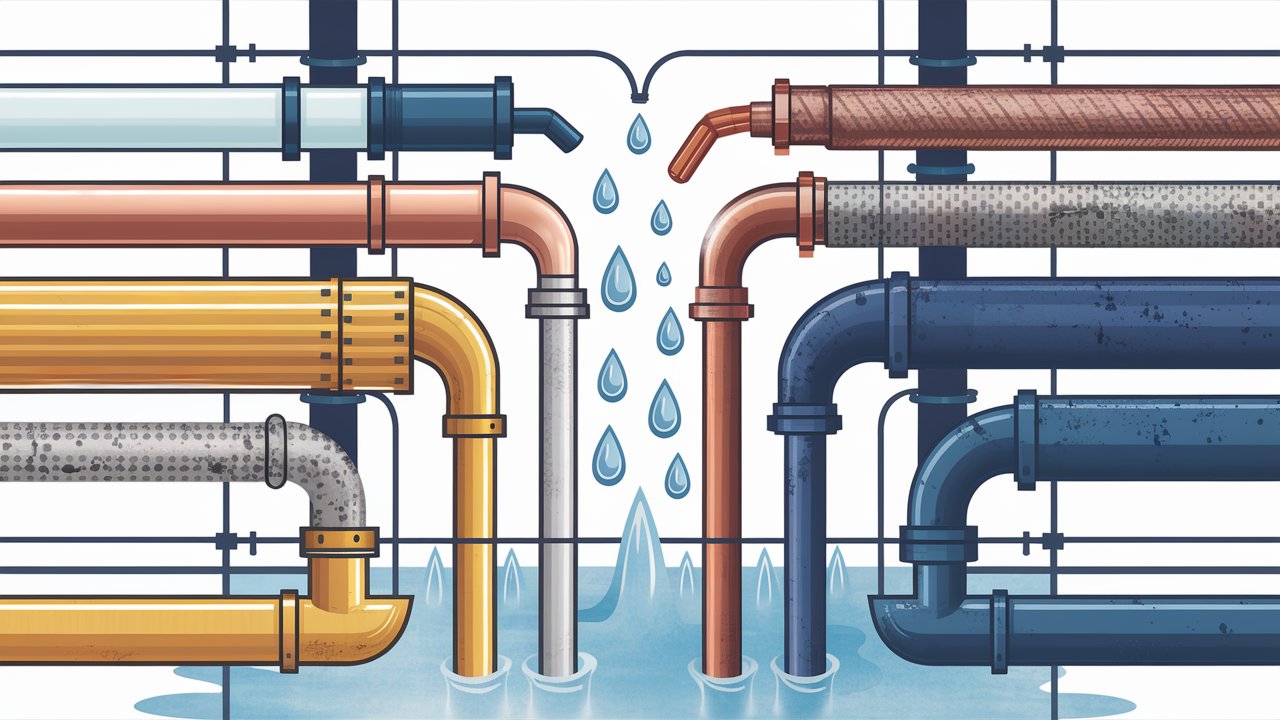Understanding the materials used in plumbing pipes is crucial for both new installations and repairs. Each material has its own set of properties that make it suitable for specific applications, from handling high pressure and temperature to resisting corrosion and chemicals. Knowing these materials helps in making informed decisions about plumbing systems, ensuring efficiency, safety, and longevity.
Plumbing pipes are designed to handle different functions within a building, including water supply, drainage, and gas delivery. Choosing the right material for each application can prevent leaks, reduce maintenance costs, and enhance the overall performance of the plumbing system.
Common Plumbing Pipe Materials
- Cast iron
- PVC (PolyVinyl Chloride)
- Chromed brass
- Chromed copper
- Galvanized iron
- Copper (rigid and flexible)
- CPVC (Chlorinated Poly-Vinyl Chloride)
- PEX (Cross-linked Polyethylene)
- Black iron
What Are Water Lines Made Of?
Water lines must be capable of withstanding high pressure and exposure to water over time. The following materials are commonly used for water lines:
- Copper (Best Choice)
- Galvanized Steel
- Polyvinyl Chloride (PVC)
- Acrylonitrile Butadiene Styrene (ABS)
- Cross-Linked Polyethylene (PEX)
- Chlorinated Polyvinyl Chloride (CPVC)
Copper is the preferred material for water lines due to its exceptional durability and resistance to corrosion. It handles high pressure and temperature variations effectively, making it suitable for both hot and cold water lines. Copper pipes are long-lasting and require minimal maintenance, which makes them a top choice for reliable plumbing systems.
Galvanized steel was once a popular choice for water lines due to its strength and durability. However, it is prone to corrosion over time, which can lead to reduced water flow and potential leaks. This material is less commonly used today, especially in new installations, due to the availability of more corrosion-resistant alternatives.
PVC pipes are lightweight and resistant to corrosion, making them a good choice for cold water lines. They are easy to install and cost-effective but are generally not used for hot water applications due to their lower heat resistance.
ABS pipes are known for their durability and impact resistance. They are often used in cold water lines and drainage systems. ABS is more resilient to physical stress compared to PVC, but like PVC, it is not suitable for high-temperature applications.
PEX is a versatile and flexible material suitable for both hot and cold water lines. It resists scale and chlorine, making it a durable option for various plumbing needs. Its flexibility simplifies installation, particularly in complex layouts.
CPVC pipes can handle higher temperatures compared to PVC, making them suitable for both hot and cold water lines. They offer good resistance to corrosion and are often used in residential and commercial applications where heat and pressure are factors.
What Are Gas Lines Made Of?
Gas lines require materials that are not only durable but also resistant to the corrosive effects of natural gas. The most commonly used materials for gas lines include:
- PVC (Best Choice)
- Flexible Corrugated Stainless Steel Tubing (CSST)
- Galvanized Steel
- Black Iron
- High-Density Polyethylene (HDPE)
- Copper
PVC is utilized for gas lines due to its robust nature and resistance to corrosion. It is strong enough to handle the pressure of natural gas and does not degrade over time, ensuring a reliable and long-lasting gas line.
CSST is a popular choice for gas lines because of its flexibility and resistance to corrosion. It can be easily routed through walls and ceilings, making it ideal for both new installations and retrofits.
Galvanized steel offers strength and durability for gas line applications. It is resistant to corrosion but is less flexible than CSST, which can make installation more challenging.
Black iron is traditionally used for gas lines due to its strength and durability. It can withstand high pressure and is effective in preventing gas leaks, although it requires proper installation and maintenance to avoid corrosion.
HDPE is used in gas lines for its flexibility and resistance to corrosion. It is ideal for underground installations and can handle the pressure and chemical properties of natural gas.
Copper is durable and resistant to corrosion, but it is less commonly used for gas lines due to its higher cost and availability of more practical alternatives.
What Are Sewer Lines Made Of?
Sewer lines must be able to handle waste and resist corrosion over time. The following materials are commonly used for sewer lines:
- PVC White Plastic Pipes (Best Choice)
- ABS Pipes (Best Choice)
- Cast-Iron
- Orangeburg
PVC is the top choice for sewer lines due to its resistance to corrosion and chemicals. It is durable, easy to install, and capable of handling the demands of waste and wastewater systems effectively.
ABS pipes are another excellent option for sewer lines. They offer high impact resistance and durability, making them suitable for handling waste materials. ABS pipes are also resistant to chemicals and provide a reliable long-term solution.
Cast iron has been a traditional material for sewer lines due to its strength and durability. It can handle high-pressure applications but is prone to corrosion over time, which can lead to maintenance issues.
Orangeburg pipes, made from fiber and asphalt, were used in the past but have largely been replaced by more modern materials. They are prone to deterioration and collapse, making them less suitable for new installations.


